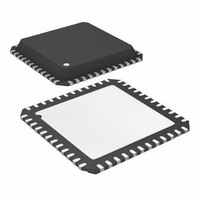ATA6613P-PLQW Atmel, ATA6613P-PLQW Datasheet - Page 243

ATA6613P-PLQW
Manufacturer Part Number
ATA6613P-PLQW
Description
MCU W/LIN TXRX REG WTCHDG 48-QFN
Manufacturer
Atmel
Series
AVR® ATA66 LIN-SBCr
Datasheet
1.ATA6612-EK.pdf
(364 pages)
Specifications of ATA6613P-PLQW
Core Processor
AVR
Core Size
8-Bit
Speed
16MHz
Connectivity
I²C, LIN, SPI, UART/USART
Peripherals
Brown-out Detect/Reset, POR, PWM, WDT
Number Of I /o
23
Program Memory Size
16KB (16K x 8)
Program Memory Type
FLASH
Eeprom Size
512 x 8
Ram Size
1K x 8
Voltage - Supply (vcc/vdd)
2.7 V ~ 5.5 V
Data Converters
A/D 8x10b
Oscillator Type
Internal
Operating Temperature
-40°C ~ 125°C
Package / Case
48-QFN Exposed Pad
Processor Series
ATA6x
Core
AVR8
Data Bus Width
8 bit
Data Ram Size
1 KB
Interface Type
I2C, SPI, USART
Maximum Clock Frequency
16 MHz
Number Of Programmable I/os
23
Number Of Timers
3
Maximum Operating Temperature
+ 125 C
Mounting Style
SMD/SMT
Minimum Operating Temperature
- 40 C
On-chip Adc
10 bit, 8 Channel
Lead Free Status / RoHS Status
Lead free / RoHS Compliant
Available stocks
Company
Part Number
Manufacturer
Quantity
Price
Company:
Part Number:
ATA6613P-PLQW
Manufacturer:
ATMEL
Quantity:
5 000
Part Number:
ATA6613P-PLQW
Manufacturer:
ATMEL/爱特梅尔
Quantity:
20 000
- Current page: 243 of 364
- Download datasheet (7Mb)
9111H–AUTO–01/11
3. The application software should now examine the value of TWSR, to make sure that
4. When the address packet has been transmitted, the TWINT Flag in TWCR is set, and
5. The application software should now examine the value of TWSR, to make sure that
6. When the data packet has been transmitted, the TWINT Flag in TWCR is set, and
7. The application software should now examine the value of TWSR, to make sure that
the START condition was successfully transmitted. If TWSR indicates otherwise, the
application software might take some special action, like calling an error routine.
Assuming that the status code is as expected, the application must load SLA+W into
TWDR. Remember that TWDR is used both for address and data. After TWDR has
been loaded with the desired SLA+W, a specific value must be written to TWCR,
instructing the TWI hardware to transmit the SLA+W present in TWDR. Which value
to write is described later on. However, it is important that the TWINT bit is set in the
value written. Writing a one to TWINT clears the flag. The TWI will not start any oper-
ation as long as the TWINT bit in TWCR is set. Immediately after the application has
cleared TWINT, the TWI will initiate transmission of the address packet.
TWSR is updated with a status code indicating that the address packet has success-
fully been sent. The status code will also reflect whether a Slave acknowledged the
packet or not.
the address packet was successfully transmitted, and that the value of the ACK bit
was as expected. If TWSR indicates otherwise, the application software might take
some special action, like calling an error routine. Assuming that the status code is as
expected, the application must load a data packet into TWDR. Subsequently, a spe-
cific value must be written to TWCR, instructing the TWI hardware to transmit the
data packet present in TWDR. Which value to write is described later on. However, it
is important that the TWINT bit is set in the value written. Writing a one to TWINT
clears the flag. The TWI will not start any operation as long as the TWINT bit in
TWCR is set. Immediately after the application has cleared TWINT, the TWI will initi-
ate transmission of the data packet.
TWSR is updated with a status code indicating that the data packet has successfully
been sent. The status code will also reflect whether a Slave acknowledged the packet
or not.
the data packet was successfully transmitted, and that the value of the ACK bit was
as expected. If TWSR indicates otherwise, the application software might take some
special action, like calling an error routine. Assuming that the status code is as
expected, the application must write a specific value to TWCR, instructing the TWI
hardware to transmit a STOP condition. Which value to write is described later on.
However, it is important that the TWINT bit is set in the value written. Writing a one to
TWINT clears the flag. The TWI will not start any operation as long as the TWINT bit
in TWCR is set. Immediately after the application has cleared TWINT, the TWI will ini-
tiate transmission of the STOP condition. Note that TWINT is NOT set after a STOP
condition has been sent.
Atmel ATA6612/ATA6613
243
Related parts for ATA6613P-PLQW
Image
Part Number
Description
Manufacturer
Datasheet
Request
R

Part Number:
Description:
MCU W/LIN TXRX REG WTCHDG 48-QFN
Manufacturer:
Atmel
Datasheet:

Part Number:
Description:
Ata6613
Manufacturer:
ATMEL Corporation
Datasheet:

Part Number:
Description:
BOARD DEMO LIN-MCM FOR ATA6613
Manufacturer:
Atmel
Datasheet:

Part Number:
Description:
DEV KIT FOR AVR/AVR32
Manufacturer:
Atmel
Datasheet:

Part Number:
Description:
INTERVAL AND WIPE/WASH WIPER CONTROL IC WITH DELAY
Manufacturer:
ATMEL Corporation
Datasheet:

Part Number:
Description:
Low-Voltage Voice-Switched IC for Hands-Free Operation
Manufacturer:
ATMEL Corporation
Datasheet:

Part Number:
Description:
MONOLITHIC INTEGRATED FEATUREPHONE CIRCUIT
Manufacturer:
ATMEL Corporation
Datasheet:

Part Number:
Description:
AM-FM Receiver IC U4255BM-M
Manufacturer:
ATMEL Corporation
Datasheet:

Part Number:
Description:
Monolithic Integrated Feature Phone Circuit
Manufacturer:
ATMEL Corporation
Datasheet:

Part Number:
Description:
Multistandard Video-IF and Quasi Parallel Sound Processing
Manufacturer:
ATMEL Corporation
Datasheet:

Part Number:
Description:
High-performance EE PLD
Manufacturer:
ATMEL Corporation
Datasheet:

Part Number:
Description:
8-bit Flash Microcontroller
Manufacturer:
ATMEL Corporation
Datasheet:











